
"It never works like you can read in the manuals," Morten Thomsen said speaking to the heart of many visitors at the beginning of the dressage training seminar he held together with German Olympic champion Ingrid Klimke on 13 April 2012. The seminar was organised by the Personal Members (PM) of German Equestrian Federation and more than 500 spectators gathered in the indoor arena of the beautiful Westfalian Riding School in Münster to experience the coming together of two remarkable equestrian personalities.
Both are Olympic riders and both have been victorious up to Grand Prix in dressage. Both presented one common aim at the seminar: creating a beautiful dressage horse through motivating and horse-friendly dressage training.
Desensitise to Allow a Stress-free Horse to Learn
Morten Thomsen, a two-time Olympic dressage rider from Silkeborg, Denmark, is renowned for his talent for training piaffe and passage. He started the evening by entering the huge indoor arena with his own Danish Warmblood gelding Real Life, which wore a simple knot halter. He gave an introduction to his own way of discovering new methods to train his dressage horses before demonstrating a first part of them. What distinguished him from some other dressage trainers, who promote alternative ways, was the fact that Thomsen claimed his method is not the only one valid. "First of all: I don't say that what I do and what you see this evening has to be practised by everybody. It is just a way I found out over the times that works the way I like it," he stated.
 In Thomsen's opinion horses are very quick learners who need about three times to take in a thing, “positive or negative.” The main problem, according to the perfectly German speaking Dane, is that we don't act consciously enough and so send wrong signals which are not understood by the horse. “If I work with a horse it is me who has to be smart. The horse thinks simple, very very simple. So my main principle is that I make it easy for my horse to do what I want him to do and difficult to do what I don't want him to do.”
In Thomsen's opinion horses are very quick learners who need about three times to take in a thing, “positive or negative.” The main problem, according to the perfectly German speaking Dane, is that we don't act consciously enough and so send wrong signals which are not understood by the horse. “If I work with a horse it is me who has to be smart. The horse thinks simple, very very simple. So my main principle is that I make it easy for my horse to do what I want him to do and difficult to do what I don't want him to do.”
First step in the training of a young horse is to desensitise it to certain influences.
Thomsen quite rightly remarked that an excited horse is like an excited man: unable to learn properly. So the first thing one has to teach a young horse is to stay relaxed whatever the circumstances and outside influences because only a calm horse listens to the trainer and learns from him effectively.
"I use three instruments to desensitise the horse from frightening noises: a plastic bag attached to a stick, a soccer rattle and an automatic umbrella. The aim is that when the noise starts the horse takes its head low into a relaxed position and stands still instead of trying to evade and run away. We don't want to increase the flight instinct of the horse! As soon as the head is low I stop the noise."
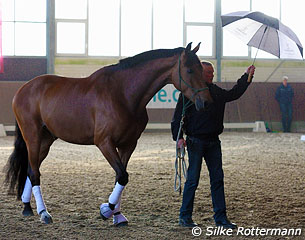 With his enchanting 8-year-old Thomsen demonstrated all three instruments. The very alert gelding (by Romanov x Leandro) wasn't cool as a cucumber in front of such a big audience and in foreign surroundings, but he proved that he has learnt his lesson. He reacted very calmly to the rustling of the plastic bag at the stick, but cringed shortly when Thomsen confronted him with the startling noise of the rattle, only to remember what he was taught: Lower the head, calm down and everything stops. Real Life remained interested, but relaxed when the umbrella shot up in front of him. What the crowd got to see was no dead horse showing no reaction like we can sometimes see in reining competitions, but a horse being attentive and alert, reacting slightly or not, but in no case panicking due to the noises. This horse always came down into the desired, low head position in which it stood almost like a statue.
With his enchanting 8-year-old Thomsen demonstrated all three instruments. The very alert gelding (by Romanov x Leandro) wasn't cool as a cucumber in front of such a big audience and in foreign surroundings, but he proved that he has learnt his lesson. He reacted very calmly to the rustling of the plastic bag at the stick, but cringed shortly when Thomsen confronted him with the startling noise of the rattle, only to remember what he was taught: Lower the head, calm down and everything stops. Real Life remained interested, but relaxed when the umbrella shot up in front of him. What the crowd got to see was no dead horse showing no reaction like we can sometimes see in reining competitions, but a horse being attentive and alert, reacting slightly or not, but in no case panicking due to the noises. This horse always came down into the desired, low head position in which it stood almost like a statue.
After he had demonstrated the principle and the instruments to get the horse to stand still and relaxed Thomsen asked the audience to start and stop clapping loudly as his sign. 500 people did like they were asked. The gelding, standing with a sagging lead-rope only in his halter next to his rider, became frightened, taking his head high and doing some hectic side-steps until Thomsen asked him calmly, but firmly to lower his head which he obediently did and everybody stopped clapping. Thomsen repeated that game a few times and Real Life no longer minded the wave of noise coming towards him. He stood there just looking on interestedly.
"The aim I have as a dressage trainer is a beautiful horse. What is a beautiful horse to me? It is one that moves without force and in lightness. If we manage to desensitise the horse to outside influences we have a horse sensitive towards the demands of the trainer," Thomsen concluded his first lecture of the evening, which was rewarded with a lot of applause.
“Respect the Horse's Personality and Don't Oppress the Horse in Its Training”
If a horse has learnt from the start to focus on the trainer's demands, it is of uppermost importance to keep up the horse's motivation and will to work in its daily training. Ingrid Klimke demonstrated how this can be achieved in an exemplary training lesson in which she trained her long-time student Lara Heggelmann on the 6-year-old Bavarian stallion Sir Schiwago.
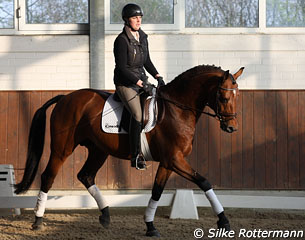 Ingrid started the session with some words to the audience. "My father has taught me to be open, keep my eyes and ears open. His motto I took on was to conceive the entity of the horse, respect its personality and don't oppress it in the training."
Ingrid started the session with some words to the audience. "My father has taught me to be open, keep my eyes and ears open. His motto I took on was to conceive the entity of the horse, respect its personality and don't oppress it in the training."
Wise words which Klimke could easily put into practise in the course of the evening. They were an inspiration to every attendant that evening inspiring them to put them in practise working with one's own horse.
The young Lara Heggelmann has been riding with Klimke for several years, having done her apprenticeship at Klimke's stable and graduating last year with the best result of all students. Now a freelance rider Heggelmann competes Klimke's former small tour horse Dante at S-level and still works closely together with her trainer.
"At the beginning of the warm-up phase it is important to walk the horse with given reins. Take it at the rein buckle if possible, otherwise as long as possible," Klimke recommended. The charming stallion, winner of the 2009 South German Stallion Licensing in Munich and owned by Kurt Gravemeier and the Zweibrücken State Stud, first walked round while taking quite an interest in his surroundings. Klimke just told Lara to continue. "It is not a drama if a horse is a bit edgy at the beginning. Just give your horse more time then." Ingrid stressed that the warm-up phase is a very important one of each training lesson because without a successful warm-up no proper useful work phase can follow.
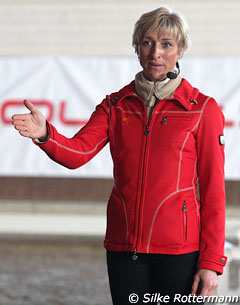 After Sir Schiwago had been worked in the longest possible reins Ingrid's diligent team, including her long-time groom Carmen Thiemann and daughter Greta, carried some cavaletti into the arena to include them in the warm-up phase. It had been Ingrid's late father Dr. Reiner Klimke who already used these white poles in the training of all his horses. Ingrid "uses cavaletti daily in the work of my horses. They are ideal for the warm-up phase because the horse activates the hind-legs and trains the muscles in a way which otherwise would be impossible during that phase. Also cavaletti work is a variation and motivates horses."
After Sir Schiwago had been worked in the longest possible reins Ingrid's diligent team, including her long-time groom Carmen Thiemann and daughter Greta, carried some cavaletti into the arena to include them in the warm-up phase. It had been Ingrid's late father Dr. Reiner Klimke who already used these white poles in the training of all his horses. Ingrid "uses cavaletti daily in the work of my horses. They are ideal for the warm-up phase because the horse activates the hind-legs and trains the muscles in a way which otherwise would be impossible during that phase. Also cavaletti work is a variation and motivates horses."
Sir Schiwago put Ingrid's words into practise. Ears pricked the bay tackled the poles and improved his rhythm each time he went over them. At the end he arched his back and top-line perfectly and pulled his hind-legs actively under, always interested in the next task.
Finally the warm-up phase was closed with some initial canter work. "I always do it standing in the stirrups to unburden the back at the beginning," Ingrid told the crowds.
Heggelmann presented the talented horse in a longer frame at the beginning of the lesson and took the stallion, which stretched exemplary onto the bit, higher when she started the working phase. Ingrid asked Lara to do a lot of transitions from trot to walk and back to trot to make the hind-legs carry more weight. Ingrid stressed the importance of a quickly and diligently moving hind-leg during that exercise."When you exercise half halts to ride the transition from trot to halt you have to pay attention to ride the transition step by step and bring the horse back slowly."
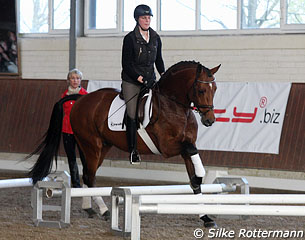 The working phase was interrupted several time by periods of walk in which Ingrid used the cavaletti again to keep the horse's focus and to secure its rhythm and attention for the next phase. each more demanding and collected exercise was followed by the horse being allowed to stretch forwards-downwards and relax and take a breather. In trot Klimke focused on lateral work like shoulder-in after a volte and transitions from shoulder-in to trot half-passes. She paid attention to almost every detail while Heggelmann repeated the movement several times until her mentor was content with it.
The working phase was interrupted several time by periods of walk in which Ingrid used the cavaletti again to keep the horse's focus and to secure its rhythm and attention for the next phase. each more demanding and collected exercise was followed by the horse being allowed to stretch forwards-downwards and relax and take a breather. In trot Klimke focused on lateral work like shoulder-in after a volte and transitions from shoulder-in to trot half-passes. She paid attention to almost every detail while Heggelmann repeated the movement several times until her mentor was content with it.
The canter phase was dominated by many transitions in between the pace and using 4 cavaletti over which Lara cantered in a dressage seat, thereby strengthening the inner hind-leg. The same aim was achieved by gradually minimizing a circle in a travers-like frame with a subsequent half halt to walk.
This demonstration reminded the spectator that younger horses require general strengthening and a maintaining of the rhythm to keep them smooth. Riding too many extensions or asking the horse for too much collection not befitting its age and training level are mistakes often seen in the dressage arena.
Conditioning the Horse from the Ground as Preparation for Piaffe and Passage
Morten Thomsen is renowned for his ground work. His horses can not only do expressive piaffe and passage, but also Spanish walk and they even bow. One can consider this remarkable, others shake their heads and think of circus. However the Dane aims to occupy his horses mentally and uses the Spanish walk to improve the shoulder freedom for passage later on.
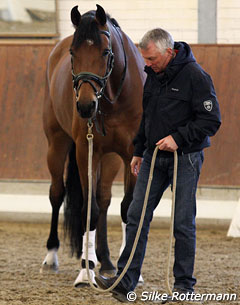 Thomsen, whose wife Sarah Arvé Thomsen watched at the sideline, re-entered the indoor arena with Real Life, this time in a snaffle bridle with the green knot halter over it and a thick heavy lead rope attached. Thomsen positioned his horse at the opposite long side of the arena facing the crowds. He explained that it is very important that a horse has learnt to stand quietly and relaxed when practising the first steps of piaffe. For that he used the method which he calls "ground tying." Thomsen formed a half-loop in the lead rope and carefully put his foot on it, transferring pressure on the halter. His gelding, which he bred himself and trained to PSG level, followed the pressure and put his head down. He didn't move a centimeter when his handler put the lead-rope on the ground.
Thomsen, whose wife Sarah Arvé Thomsen watched at the sideline, re-entered the indoor arena with Real Life, this time in a snaffle bridle with the green knot halter over it and a thick heavy lead rope attached. Thomsen positioned his horse at the opposite long side of the arena facing the crowds. He explained that it is very important that a horse has learnt to stand quietly and relaxed when practising the first steps of piaffe. For that he used the method which he calls "ground tying." Thomsen formed a half-loop in the lead rope and carefully put his foot on it, transferring pressure on the halter. His gelding, which he bred himself and trained to PSG level, followed the pressure and put his head down. He didn't move a centimeter when his handler put the lead-rope on the ground.
After Thomsen removed the knot halter, he positioned himself left to the horse and showed how to do some lateral movements in hand. "I teach young horses that they have to
yield when I apply pressure, yielding backwards, sidewards. If I get the desired reaction I stop applying pressure. Also you more easily reach the horse's brain by voice than by pulling in the mouth. I train my horses to react to my voice; for example if I want them to stop and stand still I say 'ho'."
The Dane then started introducing the crowds to his method. One is tempted to call it a philosophy, teaching a horse to piaffe from the ground. For this he used a bamboo stick. "It is cheap and it is useful. It is important that the horse gets used to it in a good way. The principle is that after touching the horse and I get the reaction I immediately
remove the stick." The desired reaction from the horse is not only that it lifts its legs, but also holds it up in the air.
 Real Life was put parallel to the kickboard and stood there patiently, reins loose and ears listening to Thomsen, who stood away from his horse. Each leg was shortly and carefully touched with the bamboo stick and the gelding promptly lifted the hind-legs higher than the opposite fetlock. "I do it the same way with the front legs, but here it is very important that the horse doesn't lift the front legs like when giving the hooves for cleaning them, which means with a sagging shoulder. Instead we have to take care the horse lifts its shoulders to practise the elevation we later need to get an elevated ground-disdaining passage."
Real Life was put parallel to the kickboard and stood there patiently, reins loose and ears listening to Thomsen, who stood away from his horse. Each leg was shortly and carefully touched with the bamboo stick and the gelding promptly lifted the hind-legs higher than the opposite fetlock. "I do it the same way with the front legs, but here it is very important that the horse doesn't lift the front legs like when giving the hooves for cleaning them, which means with a sagging shoulder. Instead we have to take care the horse lifts its shoulders to practise the elevation we later need to get an elevated ground-disdaining passage."
Because Thomsen prefers working a lot with his voice (even though it is forbidden in competition), he showed how one can condition the horse to lift the legs by voice. For this he connected the touch with a certain tone. "You have to use two different tones for front- and hind-legs. In the end the horse has learnt that the tones mean lifting the legs in turns."
Real Life knows his teacher's method and was a textbook exemplification of it. The gelding left a deep impression on the spectators that he was a horse not only able to "read and write," but which understood and was interested in every single word his master said to the visitors of the seminar. One can have different opinions on what was presented: is Thomsen's training method just a logical support system for horses learning the most difficult Grand Prix movements or is it a method close to the artificial seen in the circus. The sympathetic Dane and his horse form an outstanding partnership and have a relationship in which they understand each other; something we are all looking for.
 Standing with his back to the horse and holding the reins in his left hand Thomsen animated Real Life to piaffe in hand which he did beautifully, but the bay became crooked with the hind-legs in and the head was a bit low. "I don't mind that he's not remaining straight in hand, because under the saddle he is straight," Thomsen remarked to the crowd.
Standing with his back to the horse and holding the reins in his left hand Thomsen animated Real Life to piaffe in hand which he did beautifully, but the bay became crooked with the hind-legs in and the head was a bit low. "I don't mind that he's not remaining straight in hand, because under the saddle he is straight," Thomsen remarked to the crowd.
Due to the limited time during frame at the seminar the horse was unfortunately not presented under saddle. It would have been more than interesting to see if this method translated under the rider, or with a horse not as thoroughly schooled as Thomsen's own texbook example.
After the first exercises were shown to the public, Thomsen's wife and groom put a lunging girth and a double lunge on, while Real Life stood there patiently with nobody really holding him until everything was attached to him correctly. "If the horse has learnt to lift the hind- and front-legs rhythmically in turns while standing one can try it with the horse travelling forwards," Thomsen continued.
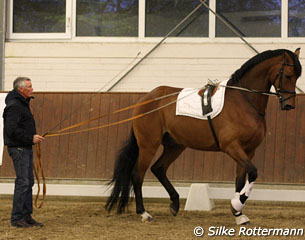 Real Life showed some impressive piaffe and passage in long lines, expressing pride and eagerness to please. He showed himself off in a positive way. It was a bit topsy turvey when Morten Thomsen made his horse bow deeply in front of the packed house at the end of his demo. One couldn't help but feeling humbled. Should it have been the crowd who needed to bow out in front of those two after having shown a different approach to piaffe and passage.
Real Life showed some impressive piaffe and passage in long lines, expressing pride and eagerness to please. He showed himself off in a positive way. It was a bit topsy turvey when Morten Thomsen made his horse bow deeply in front of the packed house at the end of his demo. One couldn't help but feeling humbled. Should it have been the crowd who needed to bow out in front of those two after having shown a different approach to piaffe and passage.
Considering all that was shown at the seminr, it all appeared a bit too nice to be true. One shouldn't forget that one needs to be a skilled and experienced horseman to be able to work effectivey like this with horses and succeed. As Morten Thomsen had mentioned earlier "To send the right signals at the right time is the secret of a successful communication with the horse." This right timing is an art in itself and can hardly be learnt from a manual!
Lightness and Harmony: Dresden Mann and Ingrid Klimke
After showing how a horse can learn piaffe and passage step by step it was Ingrid Klimke's turn to ride these highly demanding collected movements under Morten Thomsen's supervision. Ingrid had already warmed-up Clodagh Wallace's 8-year-old black Westfalian Dresden Mann outside so both could immediately start with the working phase. The very attractive gelding was a stallion until one year ago, but was gelded due to the fact that his hormones hindered him from focusing on his job.
 Ingrid frankly confessed to her audience that it was this horse that turned her to work with Morten Thomsen "by recommendation of my brother Michael and Morten advised me to castrate Alfi." Sound advice as this highly elegant and compact Dresemann-son is now 100% on the job, even though he was a bit excited at the beginning when he entered the arena.
Ingrid frankly confessed to her audience that it was this horse that turned her to work with Morten Thomsen "by recommendation of my brother Michael and Morten advised me to castrate Alfi." Sound advice as this highly elegant and compact Dresemann-son is now 100% on the job, even though he was a bit excited at the beginning when he entered the arena.
So it seemed good to start the lesson with canter, the horse bridled in a snaffle. "The aim at that stage has to be to get a bigger and more elevated canter," Morten remarked, while Ingrid demonstrated this. Dresden Mann seemed to rise in front and cantered wonderfully into the soft and feeling hands of his rider.
Both continued with lateral work and Ingrid rode some canter half-passes on both leads. "It is important that we start with long flat half-passes so the horse is animated to move forwards and upwards," Thomsen commented on the pair, which in the course of the next few minutes increasingly showed half-passes becoming steeper and more demanding for the horse. As the exercise became more strenuous the horse began to “talk” by grunting a bit to express its effort to make it right.
Ingrid then followed with canter work, showing tempi changes up to one-time-changes. This horse which had placed highly at the World Championships for young dressage horses at Verden two years ago is already very advanced and Klimke intends to start him in the Nürnberger Burgpokal qualifier and young Grand Prix horses' classes this year. Dresden Mann has already won S- classes this spring, some in a snaffle!
While one saw that the flying changes needed to become more straight in future, it was absolutely undeniable that the quality of riding by Ingrid (not only on that particular evening) is absolutely speaking for itself. Never will you detect a hard or visible impact on the horse at all. Ingrid's copybook seat, her feeling for the movement and the horse and the excellent training all her horses receive enabled her to present Dresden Mann in an outline rarely to be seen to that extent in competitive dressage any more. The horse expressed brilliance because it was carrying itself, the poll at the highest point, the nose in front of the vertical, the hind-legs effortlessly moving under the centre of gravity, generating true impulsion and thereby true collection. This was proven when she practised the pirouettes. It is a crucial movement which reveals if a horse is balanced and collected and has sufficient self-carriage.
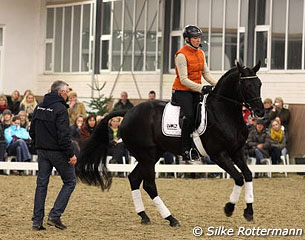 Ingrid started doing pirouettes in walk on both hands first. It was emphasized that, like in canter, it is essential to make the horse moving quickly with its inner hindleg, but also to ride each step consciously to be able to determine the number of steps and to be able to exit from the pirouette.
Ingrid started doing pirouettes in walk on both hands first. It was emphasized that, like in canter, it is essential to make the horse moving quickly with its inner hindleg, but also to ride each step consciously to be able to determine the number of steps and to be able to exit from the pirouette.
When Morten Thomsen was satisfied with the walk pirouettes he worked on the canter ones with Ingrid. From the ground he supported the gelding by standing very close to him while Ingrid circled around. “Alfi” as the black beauty is nick-named executed sitting canter pirouettes in a very good rhythm, maintaining his self-carriage without losing the contact with the bit.
The crowning moment of the evening was at the end of this high-quality lesson: Piaffe and passage work. The rather small and compact Dresden Mann showed these movements the way they should be: lowered haunches, slightly lowered croup, literally “growing” in front because the shoulders are “freed” from the weight which should be carried behind.
Regretfully one has to state that despite the highly improved breeding standard which aims to create highly talented and rideable horses, one still sees many horses with no idea about a true piaffe or passage because they were never properly taught true impulsion and true collection. By following the old principles from the beginning such a perfect horse-type like the one Ingrid presented that evening in Münster is able to make piaffe and passage look like child's play.
 Morten Thomsen hadn't a lot to do moving next to the horse and supporting it in piaffe by touching its croup. Dresden Mann's piaffe was close to perfection, sitting deep on his haunches, showing energetic steps and remaining absolutely elevated and almost too light in the bridle. The horse's tail kept quiet and only swished slightly in the transition to passage, showing that he felt quite comfortable in this movement while many stressed and overasked horses have a tail swooshing like a propellor.
Morten Thomsen hadn't a lot to do moving next to the horse and supporting it in piaffe by touching its croup. Dresden Mann's piaffe was close to perfection, sitting deep on his haunches, showing energetic steps and remaining absolutely elevated and almost too light in the bridle. The horse's tail kept quiet and only swished slightly in the transition to passage, showing that he felt quite comfortable in this movement while many stressed and overasked horses have a tail swooshing like a propellor.
After three hours of exciting and interesting demonstrations the seminar came to an end. It left the impression that the old proverb about the many roads leading to Rome is also valid in dressage. As long as these ways are horse-friendly and the result is a motivated, happily working dressage horse moving in lightness, the question is 'Why not?'
Text and photos by Silke Rottermann for Eurodressage.com
Related Links
FN Training Seminar with Hess and Graf: "Quality Equitation Leads to Success"
A Coming Together of Minds at the 2011 FEI Young Horse Seminar and Judges Course
Ingrid Klimke Receives Riding Master Title
St. Moritz Junior in Training with Ingrid Klimke